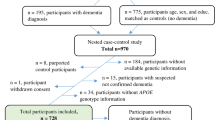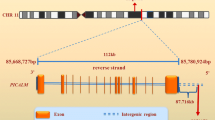Abstract
The deposition of βA4-amyloid in senile plaques in the brain and small cerebral vessels is one of the pathological hallmarks of Alzheimer’s disease (AD). Serine protease inhibitors (serpins) such as α1-antitrypsin and α1-antichymotrypsin have been found to be associated with β-amyloid deposits; interest in their role in the pathogenesis of AD has therefore recently increased. We have analyzed α1-antitrypsin phenotypes in a sample of 29 Polish patients with probable Alzheimer’s disease. We have found an increased frequency of the PI*M3 allele (0.1897) in patients in comparison with the general population control (0.0563).
Similar content being viewed by others
Author information
Authors and Affiliations
Additional information
Received: 8 May 1996 / Revised 28 June 1996
Rights and permissions
About this article
Cite this article
Kowalska, A., Danker-Hopfe, H., Wender, M. et al. Association between the PI*M3 allele of α1-antitrypsin and Alzheimer’s disease? A preliminary report. Hum Genet 98, 744–746 (1996). https://doi.org/10.1007/s004390050297
Issue Date:
DOI: https://doi.org/10.1007/s004390050297




